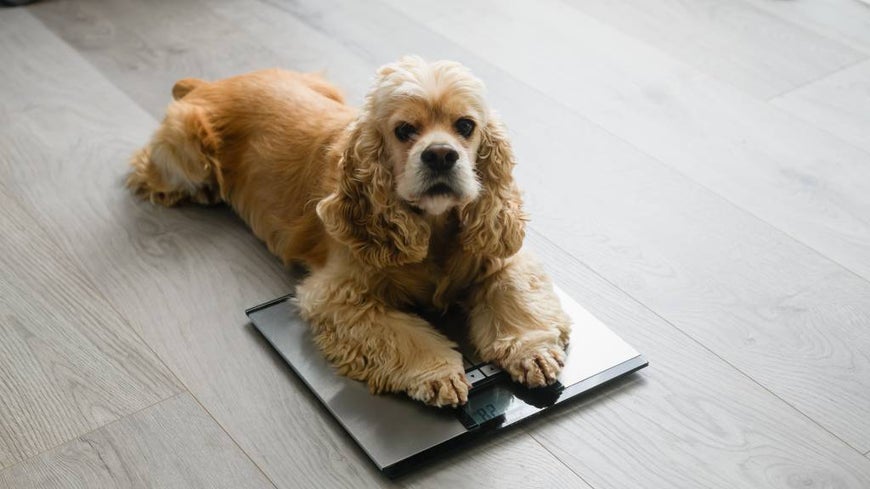Does my pooch look big in this?

Written by Monique Butterworth for Seniors Pet Insurance.
Carrying a little ‘COVID weight’ has become our go-to excuse post-pandemic for letting ourselves go a tad, but it seems too many of us have extended the justification to our pets as well. We humans know balanced nutrition and regular exercise contributes greatly to our wellness; the same goes for our pets’ prolonged good health.
According to a 2020 Australian Veterinary Association report, 41% of dogs and 32% of cats were obese, and vets have since reported the pandemic made the problem worse, thanks largely to lots of people working from home and resorting to treats to keep their pets quiet.
Petstock vet Dr Tara Morris says there are many reasons why pet obesity is still on the rise. “Everybody’s lives are busy. Sometimes people have difficulty finding the time to exercise their pet,” says Dr Morris. “We can be ‘soft touches’ too when they give us those puppy dog eyes wanting treats and extra food.”
What should you do if you notice your pet is gaining weight?
She says pet owners often don’t realise their furry friend is gaining weight, but they need to, because it is a serious health concern that can affect your pet’s lifespan. “Obesity impacts a number of your pet’s body organs, but the most common ailment people think of is osteoarthritis and joint disease from carrying the extra weight around,” says Dr Morris. “But similar to obese humans, pets become susceptible to issues like heart disease, diabetes and liver problems.
“Another issue many owners don’t think of is skin disease, particularly obese cats with skin folds who can’t groom themselves properly. Infections can develop between those folds,” she adds.
Just like people, animals come in all sizes and have different metabolisms. Some dog and cat breeds are more predisposed to gaining weight than others and whether or not the pet is desexed can make a difference too. “Like humans where you can have one person that ‘looks’ at cake and puts on weight and another who eats the whole cake and doesn’t gain anything, sometimes it just comes down to individual genetics.
How can I tell if my pet is overweight or obese?
“What might be a healthy figure on the scale for one animal is not the same for another animal, even if they’re the same breed. Rather than just look at the numbers on the scale, we observe the pet too. How easy is it for us to feel their ribs? If you have to put a fair bit of pressure on to feel a pet’s ribs or you can feel a thick coating of skin over those ribs, the pet is most likely overweight.”
She suggests pet owners check to see if their dog or cat has a ‘waist’. “Behind the ribs, dogs and cats should have a little waist that tucks in and expands again for the hips. If that is not there and they look a little like a table top, or their tummy is bulging or sagging, your pet is probably carrying too much weight.”
One of the signs your pet’s health is being affected by their weight is if they become lethargic and struggle to exercise. “If your pet is developing other diseases because of their weight, they might have trouble getting up in the morning due to developing arthritis. They might be drinking too much water and urinating more, which can be a sign of diabetes,” says Dr Morris, noting your vet can advise if your furry friend needs to be on a “proactive weight loss plan”.
Make sure weight loss is gradual
Weight loss, too, needs to be in moderation. “It needs to be a gradual process. You don’t want your pet having sudden weight loss due to excessive exercise or overzealous food restraint, particularly if your pet is not used to exercise. Taking them on a five-kilometre run is not going to be good for anybody,” says Dr Morris. “Building up exercise as they lose weight will ensure they gain more energy and they will feel happier and more comfortable to do those longer walks as time progresses.”
5 tips for healthy weight in pets
By Dr Tara Morris
- Devise an exercise routine tailored for your pet. For example, a senior dog is not going to run around or need a high amount of exercise but it needs consistent small walks to keep muscles strong and burn some calories.
- Ensure your pet has a nutritious, balanced and portion-controlled diet. Stick to the daily recommended intake on the packaging.
- Make sure all family members are on board with your pet’s new regime so you know when your pet is being fed and what they are eating.
- Don’t allow your pet to graze as some are not good with self-control. Have set meal times for your pet and stick to them.
- Take care not to give too many treats to your pet or feed them table scraps. These can deliver a lot of calories, often more than we realise for the size of the pet.
Keeping your pet’s weight in control is all part of good pet care but sometimes, illness and accidental injuries can still happen which could mean expensive vet bills! Help your pet get the care they deserve with Seniors Pet Insurance.
22 Oct 2023